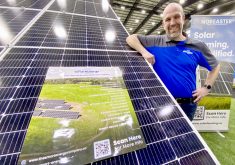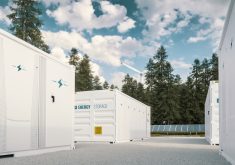For producers with less seasonally-concentrated energy demands and easier access to higher-demand grid infrastructure, renewable energy technologies like solar panels and biodigestors can significantly reduce or eliminate energy costs.
Small scale biodigestion
Robert McKinlay, a dairy farmer from Oxford County, incorporated a “microdigestor” to process the manure generated by his 90-cow dairy herd. The 20-kilowatt system is about one-tenth the size of a typical on-farm biodigestor, feeding that power into two separate 10 kilowatt engines — one going to power the barn, the other being sold back to the grid. Residual electricity from the barn portion is also fed into the grid.
Read Also

Ontario’s agri-food sector sets sights on future with Agri-Food 2050 initiative
The first-ever Agri Food 2050, a one-day industry event dedicated to envisioning the future of food and farming in Ontario,…
“We are able to use the grid as a bit of a battery,” says McKinlay. “We’re a single-phase connection. That 10-kilowatt mark is a kind of a threshold where there’s potential for higher engineering and infrastructure costs.
“Our objective is to have a similar 10-year return as any other equipment we have for the dairy.”
McKinlay also says post-digested material is separated and used as fertilizer and bedding, further improving his return on investment.
Solar hogs
Off-grid solar panels proved to be the most effective power source for Wouter van Leeuwen’s Ridgetown-area hog barn.
Using panels individually controlled and monitored through his smartphone, van Leeuwen says his system offsets approximately one-quarter of his electricity consumption. The panels are oriented in a more westerly direction to specifically “match when the sun and demand are the same,” allowing him to offset costs primarily during peak hours.The energy produced by the panels is only used to limit the amount of energy drawn from the grid, however, and no excess energy is fed back. This type of closed solar system, says van Leeuwen, is the only one he is aware of in Ontario.
“We are displacing [electricity]. It’s just using less, like turning off a lightbulb,” says van Leeuwen. “We’re producing hydro for 10 cents a kilowatt over the lifetime of the system. I’m essentially pre-paying a quarter of my hydro bill for the next 25 years.”















